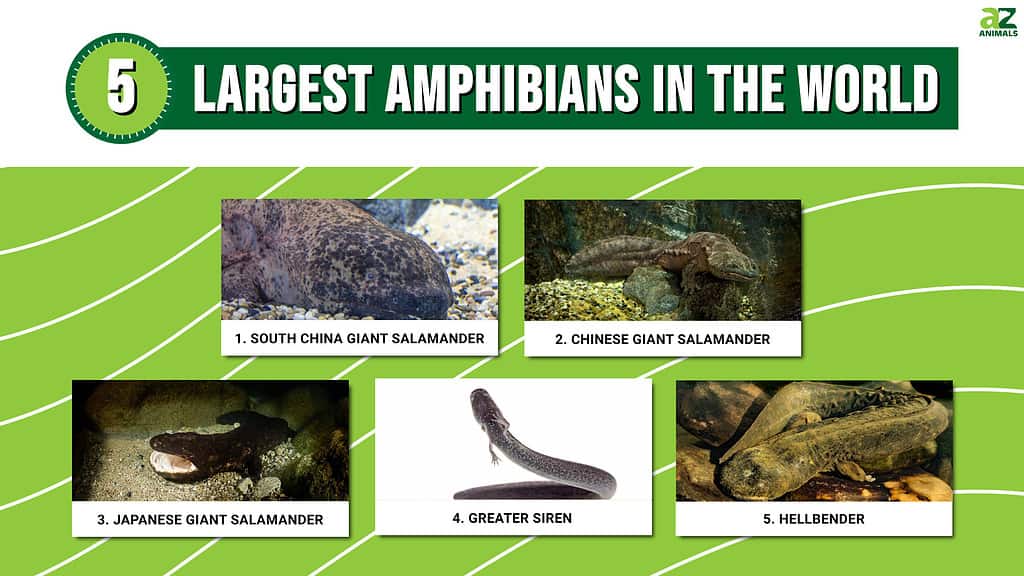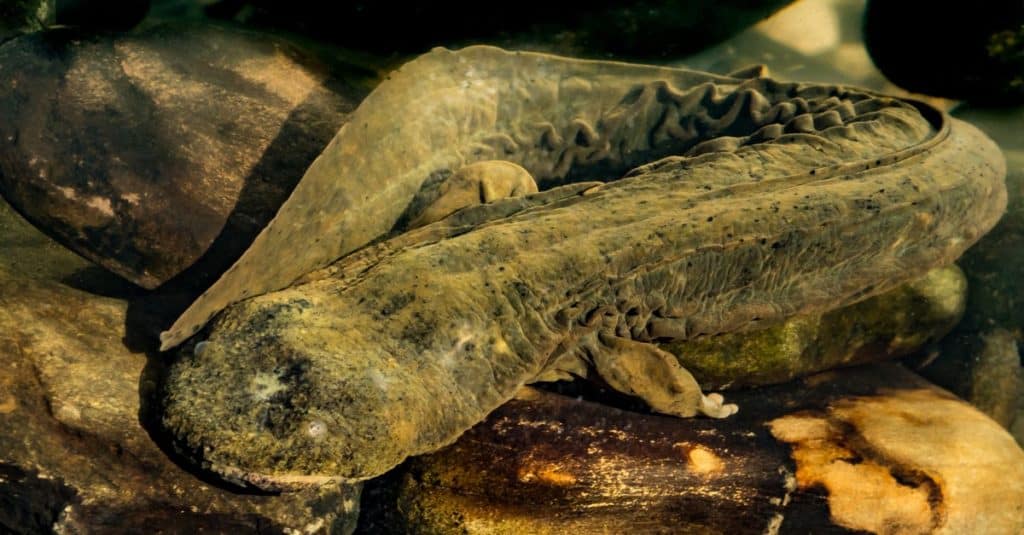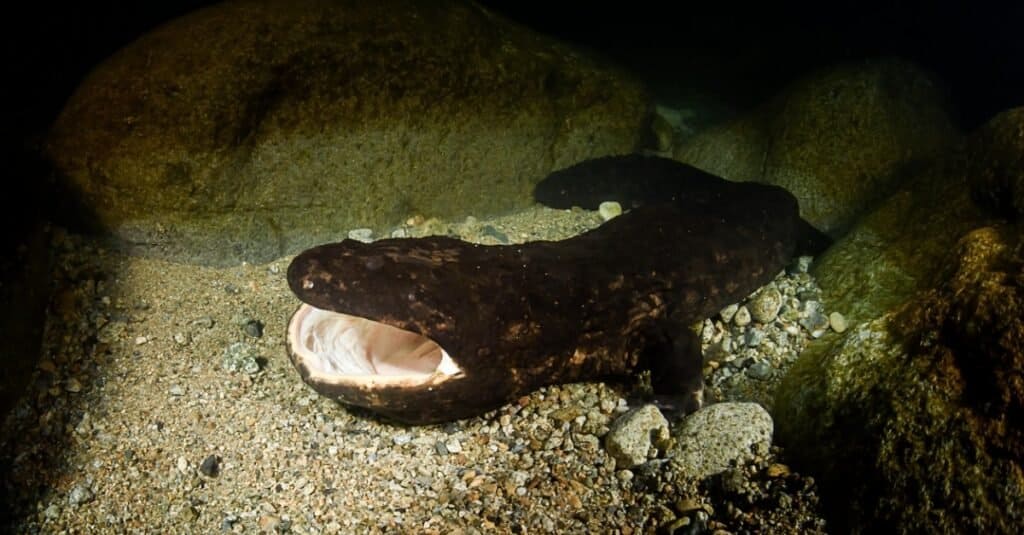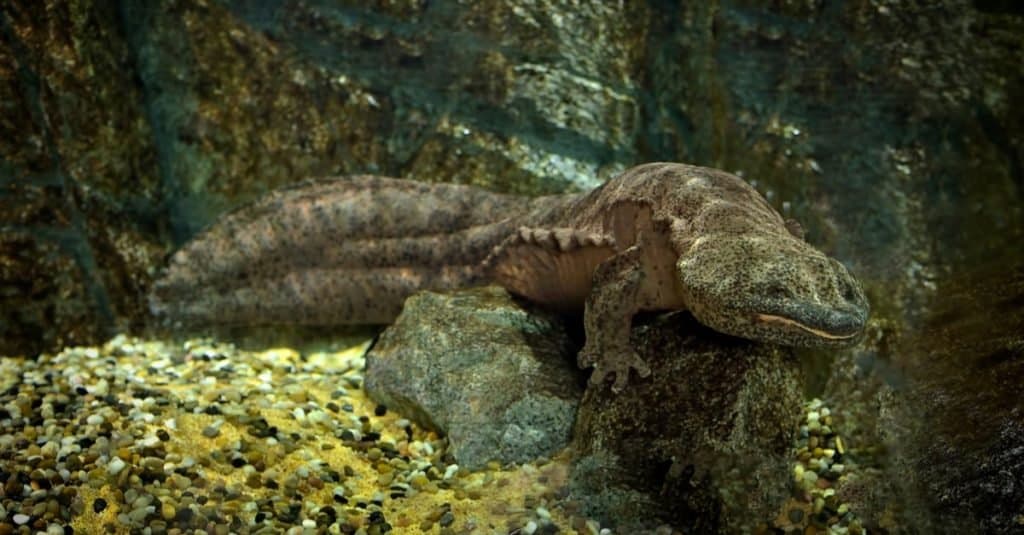Frogs, salamanders, and other amphibians aren’t known for being especially large creatures. Although many species of amphibians exist, most of them aren’t more than a few inches long. However, a few of them are actually quite big. That’s why we will take some time to show you five of the largest amphibians in the world. Not only will you learn how big an amphibian can get, but you’ll see why it’s necessary to take action to protect these animals.

What Are the Largest Amphibians in the World?
Coming up with a list of the largest amphibians in the world might seem easy on the surface. However, this list does contain a fair bit of controversy. After all, one of these species could actually be five different cryptic species that are too hard to tell apart.
Nevertheless, we will introduce what could be considered the largest amphibians in the world and show you just how large they can grow!
5. Hellbender

Hellbender salamanders can reach 30 inches long
©Jay Ondreicka/Shutterstock.com
Cryptobranchus alleganiensis is commonly known as the hellbender salamander. This aquatic salamander can grow to lengths of between 12 and 30 inches, making it one of the largest salamanders in the world. The hellbender is shorter than the greater siren, another amphibian that is found in the United States. However, they are often heavier since they have thicker bodies.
The hellbender lives in the eastern U.S. from New York south to Mississippi and west to Missouri. However, they live away from coastal plains and only thrive in the northernmost reaches of most southern states like South Carolina, Georgia, and Alabama. Hellbenders are hard to find as they live under large rocks and other covers in fast-moving waters, mostly streams.
4. Greater Siren

Greater sirens can reach an incredible 3 feet long
©Rosa Jay/Shutterstock.com
First on the list of the largest amphibians in the world is the greater siren, Siren lacertina. This amphibian can grow upwards of 3 feet long! The greater siren is eel-like in its appearance, with green or grayish bodies with yellow or green flecks on their bodies. They have a flattened tail that makes them resemble an eel and two reduced forelimbs that each have four toes.
The greater siren lives in the coastal areas of the southeastern United States. They are often found in various wetlands, living in still bodies of water that have a lot of vegetation. When the weather is hot and dry, they can enter a state of dormancy called aestivation in which they can live for years. Not only are they large amphibians, but they’re also very interesting!
3. Japanese Giant Salamander

The Japanese giant salamander can weigh as much as 50 pounds!
©iStock.com/Martin Voeller
The Japanese giant salamander is much longer than the greater siren and hellbender, measuring upwards of 5 feet! Even if you are not impressed by their length, you have to consider that they can weigh over 50 pounds! These creatures are gigantic, and they are much larger than the first two entrants on the list of largest amphibians in the world.
Like the hellbender, you can find this salamander living at the bottom of flowing streams. Their bodies are mottled black and brown, so it is very hard to see them. Still, they are listed as a near-threatened species by the IUCN because they have been over-collected, and their habitats continue to be polluted. Currently, they are only found in the southwestern portions of Japan.
2. Chinese Giant Salamander

Chinese giant salamanders are critically endangered and can reach almost 6 feet long
©tristan tan/Shutterstock.com
The Chinese giant salamander is one of the largest amphibians in the world, and it grows up to 5.9 feet in length. Andrias davidianus is found in central eastern China. The species is known for its wrinkly skin and brown coloration, even though other colors have been found. They are critically endangered and rarely found in the wild.
They average about 3.8 feet in length and weigh upward of 66 pounds, but the largest ones can get as long as 5.9 feet and weigh 130 pounds. This species is often credited as the biggest amphibian, but we’ll get to that controversy in the next section.
1. South China Giant Salamander

The South China giant salamander is critically endangered and may even be extinct in the wild.
©Danny Ye/Shutterstock.com
The South China giant salamander is the largest amphibian in the world, measuring 5.9 feet long and possibly even larger. This species was recently rediscovered in a sense. They were lumped in with the Chinese giant salamander, but they have been redefined as Andrias sligoi. However, studies in 2018 and a paper published in 2019 clarify the scientific community’s thoughts on the matter.
These two species are different. However, it is presently unknown if any wild members of this species survive in the world today. The only ones left may be living in captivity. They are listed as critically endangered by the IUCN.
They used to live in southern China, specifically in the Pearl River basin. The biggest specimen of Andrias sligoi ever described was 5.9 feet long, meaning that it is at least as long as the Chinese giant salamander. In other words, these salamanders could be the largest amphibians in the world, but we don’t know for certain.
Controversy About the Largest Amphibians in the World
We’ve covered the largest amphibians in the world, but the ordering may not be correct. The South China giant salamander (Andrias sligoi) and the Chinese giant salamander (Andrias davidianus) were once thought to be members of the same species. Recent evidence suggests that this is not the case.
Instead, what is known as the Chinese giant salamander could be five different cryptic species that have interbred in some places and become nearly indistinguishable.
Scientists have said that the Andrias sligoi is different than the Andrias davidianus. Furthermore, a new species has been identified, Andrias jiangxiensis, the Jiangxi giant salamander. This one has a genetically pure population that lives in the wild, and it could also measure 6 feet long.
As a result, our list could look very different moving forward as scientists try to figure out exactly how to parse these species. The Jiangxi giant salamander could certainly find its way onto the list of the largest amphibians in the world!
Summary of The 5 Largest Amphibians in the World
| Rank | Amphibian | Location | Length |
|---|---|---|---|
| 1 | South China Giant Salamander | South China | 5.9 feet |
| 2 | Chinese Giant Salamander | Central Eastern China | 5.9 feet |
| 3 | Japanese Giant Salamander | Southwestern Japan | 5 feet |
| 4 | Greater Siren | Southeastern United States | 3 feet |
| 5 | Hellbender | Eastern United States | 12 – 30 inches |
The photo featured at the top of this post is © Jay Ondreicka/Shutterstock.com
Sources
- Savannah River Ecology Laboratory, Available here: https://srelherp.uga.edu/salamanders/sirlac.htm
- Florida Museum, Available here: https://www.floridamuseum.ufl.edu/100years/greater-siren
- National Wildlife Federation, Available here: https://www.nwf.org/Educational-Resources/Wildlife-Guide/Amphibians/Hellbender
- Wiley Online Library, Available here: https://onlinelibrary.wiley.com/doi/10.1002/ece3.5257
- South China Morning Post, Available here: https://www.scmp.com/news/china/science/article/3179545/meet-new-wild-species-pure-chinese-giant-salamanders-raising
Thank you for reading! Have some feedback for us? Contact the AZ Animals editorial team.






